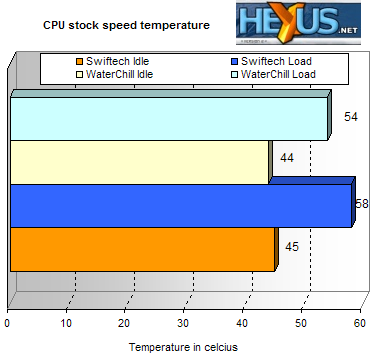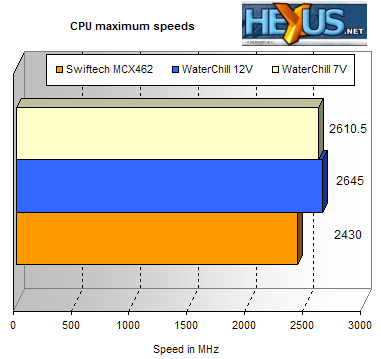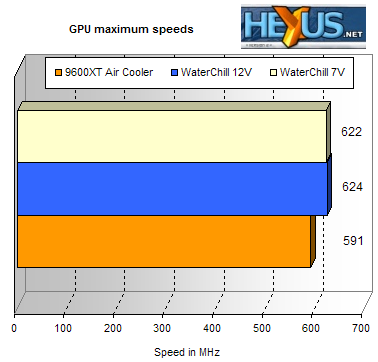Performance
I'll be testing the cooling performance in a couple of different scenarios, both for CPU and GPU overclocking, bear with me while I explain shortly. Test setup first.- Asetek WaterChill KT12-L20 (sans chipset block)
- Swiftech MCX462/478 w/ Panaflo L1A @ 12V
- ATI Radeon 9600XT, 128MB, AGP8X, RV360
- AMD Athlon XP3200+, 11 x 200MHz, 512KB L2, 2200MHz
- ASUS A7N8X 2.0 Deluxe, NVIDIA nForce2 Ultra 400, Socket A, dual DDR400
- Corsair XMS3200LLPT, 2 x 256MB, 2-2-2-5
- Enermax 431W PSU
- Seagate Barracuda ATA IV 80GB
The WaterChill was run in 12V/2300rpm fan mode for the temperature testing and in 12V and 7V modes for the overclocking testing.
CPU overclocking tests were run with the GPU at factory clock speed (500MHz). GPU overclocking tests were run with the CPU at factory clock speed (2200MHz) and voltage (1.65V).
CPU voltage for the overclocking tests was 1.85V (board maximum). CPU overclocking was done using a combination of multiplier and front side bus adjustment.
CPU load temperatures were generated by running the HEXUS SETI benchmark unit and measuring temperature after half an hour of constant CPU activity. Idle temperatures were measured after 10 minutes of inactivity.
Successful CPU overclocking was deemed to have taken place if the CPU passed a 10x repeated run of the HEXUS Pifast benchmark. Successful GPU overclocking was deemed to have taken place if the GPU passed a 3x repeated loop of 3DMark03, without any visible artifacting or other problems.
Here are the graphs.
CPU temperature performance at stock CPU speed first, to get a feel for the difference water cooling has over decently powerful air cooling.

While the numbers initially don't look that impressive, 4 celcius over a high performance air cooler isn't to be sniffed at. While XP3200+ stock cooling is easy meat for £10 Coolermaster air coolers, never mind water or high end air, WaterChill does well to open up a gap, however slender. We can understand the idle temperature gap being so low, given the capacity of Swiftech's long-term air cooling virtuoso.
How does that translate into overclocking headroom for the processor?

It's here that increased heat bearing capacity (often referred to as C/W, or celcius rise per extra W of heat produced) of the WaterChill, versus its air cooled rival, shows its face. While a 4C difference at stock CPU speed isn't that impressive, a 200MHz clock speed advantage when overclocked is. 11.5 x 230MHz for the 12V speed, we don't lose that much (3MHz front side bus speed) when dropping to the much quieter 7V operating mode. That's what your money buys you. GPU performance now, with CPU speed back at 2200MHz.

With the Radeon 9600XT already doing an impressive 591MHz using its puny air cooler, a nice increase from the WaterChill block was definitely expected. It was definitely seen too, 624MHz a very useful increase over the air cooled result (5% in total). Only losing 2MHz in 7V mode vindicates its usage in almost all reasonable scenarios. The fan is overly loud to my ears at 12V, the 7V mode reduces things reasonably, making it much less offensive and easy to live with.
I had high hopes for watercooling the CPU and it seemed to work excellently. It's not that far off the VapoChill XE results either, although a different XP3200+ example was used. I fear the new CPU is a damn good overclocker, a 2.8GHz processor in a VapoChill XE I'd bet, especially in a board that could give it more juice.
In 7V mode it was quiet too.









